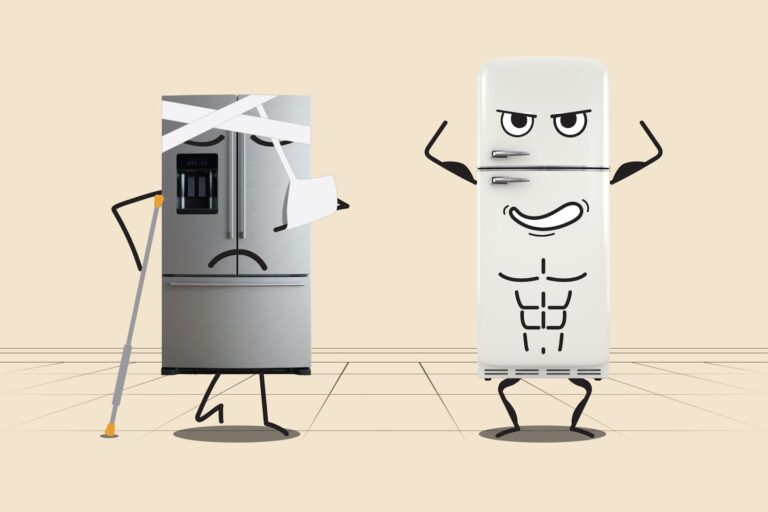Perhaps no one knows the specific limitations of a new appliance better than the person who will be responsible for repairing it.
“In the old days, people would say a dishwasher would last 15 years, but now you're lucky if your dishwasher lasts five to seven years,” says David Costanzo, owner of Appliance King of America in Boynton Beach, Florida.
Costanzo has a completely original GE refrigerator from 1935 at home that he says “works perfectly well,” but these days, “you're lucky to get 10 to 15 years out of your refrigerator. Ten to 15 years ago, that figure was closer to 20.”
One big reason is the switch from mechanical to electrical power sources for equipment.
“Appliances have a lot more sensors on them,” says Darin Williams, owner of Reliable Appliance in Anchorage, “and now motors have digital integrated into them instead of being fully mechanical motors. So as so many things are becoming digital, those types of components are more susceptible to failure than something that's analog and mechanical.”
In a modern home appliance, you’re less likely to turn a dial that activates a motor (mechanical systems) and more likely to press a button on a screen that connects lots of tiny components to a motherboard (digital integration). The more complex it is, the more opportunities there are for things to go wrong.
“The motherboard controls everything,” says Leonard Ben Frey, owner of Optimal Appliance Repair in Washington. And that has big implications when it breaks down, because the control board can often cost as much as half the price of the entire appliance. In other words, repairing it can cost almost as much as buying a new one.
And even if you want to repair rather than replace, it might not be easy to do. When it comes to electronic parts, “the pace of change is so rapid that a company might make something one year and then not make that part two years later,” says Michael Pecht, distinguished professor of mechanical engineering at the University of Maryland. “You're making the next generation of parts, and that new part might not fit the old part.”
Pecht has consulted for major brands in the United States and the European Union. He said some of their CEOs and vice presidents have lamented the difficulty of competing with Chinese companies, which often promise very cheap products. “There's a lot of pressure on Chinese companies to make their products cheaper,” he said. “So when they think about making it cheaper, what they do is they cut back on materials. They don't use the highest quality materials.”
Yes, there's a lot of plastic in there. And, of course, plastic is more likely to break than metal. “One of the biggest causes of breakdowns we see is broken parts,” says Daniel Wroclawski, a Consumer Reports reporter who covers home appliances. Parts like shelves, ice makers, water dispensers, and ice makers are more likely to break than they used to.
Plastics have advantages: They're easy to mold into intricate parts, and their light weight makes them cheaper to ship. Metals aren't perfect either; they can rust, for example. But the metals used today are of lower quality than the sturdy metals used in appliances 20 or 30 years ago. “The metals are a little thinner. The wires are a little thinner,” says David Oliva, president of RD Appliance Services in Plainview, New York.
Manufacturers continue to push smart, internet-connected appliances. Wroclawski says there's no sign yet that such features have led to more breakdowns. In fact, internet connectivity can sometimes be useful for repairs, especially in remote areas. “But the more complex you make these devices, the more likely they are to one day break down,” he says. (Cybersecurity experts warn that smart appliances can make online networks in the home more vulnerable, and that connected appliances constantly send collected data about usage to their manufacturers.)
And because the vast majority of consumers don't use the WiFi capabilities of their appliances, according to a survey conducted by Consumer Reports, there's little benefit to this increased risk. “Most appliance owners don't use the smart features or aren't even aware that they have them,” Wroclawski says. “Frankly, the use cases aren't all that compelling.”
However, manufacturers have not given up on adding further features.
“It's like a space race for consumer electronics,” says Alaska refurbishing contractor Williams. “The manufacturers who create the coolest products that excite the consumer market are more likely to sell them, while consumers then get their hands on them and realize that the features aren't something they need or will use.”
In fact, when asked about things to keep in mind when buying a new appliance, DC repairman Ben Fraj said that extra features are often a nuisance at best, and can lead to premature repairs at worst: In his opinion, the best appliances “don't have time for all that crap.”


